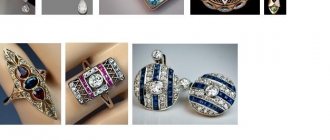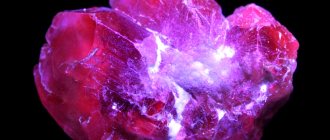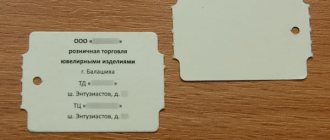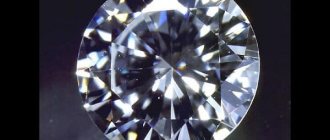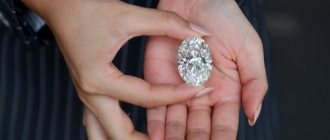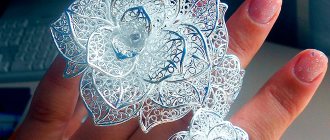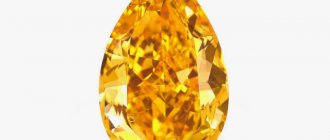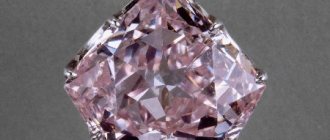BLOG OF THE HOUSE “LOBORTAS”
Part One - Garrard
The history of Asprey & Garrard, “Asprey and Garrard” is almost a three-hundred-year chronicle of two ancient English jewelry houses Garrard & Co and “Asprey”, which have a rich history and established traditions.
And despite the fact that their joint union lasted only four years, each of the jewelry Houses made their invaluable contribution to the world jewelry treasury. In the old days, as today, among royalty and nobility, talented jewelers were honored and respected and were worth their weight in gold. They were entrusted with the creation of crowns and royal regalia, weapons, tiaras, pendants and necklaces, wedding and engagement rings, buttons and cufflinks. There were queues of people who wanted to possess this shining splendor, because jewelry is an aura of power and might, greatness and status.
House of Garrard
A similar fate was destined for the talented master George Weeks (1698-1761). By the time Wicks was 24, he was already a member of the Goldsmiths' Guild, and had become famous as an accomplished silversmith for his work in the Rococo style. In 1722, despite his youth, George took the risk of starting his own business. This event heralded the beginning of a dizzying career for the jewelry house, which would later become known as Garrard&Co.
The official foundation of the Garrard & Co jewelry house dates back to the moment the Wicks workshop moved to the goldsmiths' district, in the center of London on Panton street in 1735. He is patronized by the Prince of Wales, Frederick. In the books of Garrard & Co there is an entry dating from 1735: "HRH Frederick, Prince of Wales".
Frederick Lewis Prince of Wales by Philip Mercier.
It is safe to say that throughout its history, the jewelery house of Garrard & Co has worked closely with the British royal family, starting with Frederick, Prince of Wales and each subsequent British monarch, creating many beautiful jewels.
Gradually, George Weeks's workshop is turning into a serious, dynamically developing and prosperous company, creating magnificent luxury jewelry.
Necklace pendant. Gold, diamonds, emeralds, enamel. Garrard&Co, 1870. Sotheby's New-York.
During its existence, Vicks' company was repeatedly passed from hand to hand, changing its owners. In 1760, George Wicks's company was acquired by his students John Parker and Edward Wakelin, and in 1776 they were replaced by John Wakelin and William Taylor. In 1792, after the death of William Taylor, Robert Garrard became a partner in the company. In 1802, Robert Garrard became the sole owner of the George Wicks company and transferred control to his sons Robert Garrard II, James and Sebastian. The brothers succeeded in management until James retired in 1835, changing the name to R & S Garrard.
In 1843, the most important event in the history of the Garrard jewelry house took place: the young Queen Victoria awarded the House the honorary title of court jeweler.
Queen Victoria.
The privileges granted opened up endless possibilities for Garrard & Co. From now on, the design of the official royal jewels and regalia, their production and maintenance, as well as the care of the monarch's collection of silver and jewelry became the responsibility of the House of Garrard. For 166 years, every winter for two weeks, Garrard & Co sent a team of its craftsmen to the Tower, and the jewelers, guarded by armed guards, carried out preventive maintenance and repairs to the royal jewels.
Royal treasures in the Tower.
In 1848, Garrard & Co created a cup called the America Cup. The America's Cup is one of the most famous and most prestigious regattas in the world. It is the world's oldest international competition in all sports, predating the FA Cup by two decades and predating the first modern Olympic Games by 45 years, and is the oldest international sports trophy.
America's Cup
In 1849, the Indian treasury of Lahore, which contained the famous Koh-i-noor diamond, came into the possession of the British authorities. On April 6, 1850, the Koh-i-noor left India and reached Britain on July 2, 1850, where it was handed over to Queen Victoria. In 1851, the diamond was exhibited at the Great Exhibition in London.
The Koh-i-noor diamond at the Great Exhibition in London in 1851.
Despite the fact that the precious stone had a bad reputation as an object that brought misfortune to the owner, the queen ignored prejudice and wore it in her crown. By that time, “Koh-i-noor” still retained the shape of the ancient Indian cut.
In this form, the Koh-i-nor diamond was given to Queen Victoria in 1851.
Prince Albert, along with jeweler Sebastian Garrard, said that the gem has a rose shape inappropriate for a diamond and that the new cut will make the Koh-i-noor sparkle anew. They decided to turn to experienced mineral cutters. To carry out the work, a small machine with a steam engine was made. After 38 days of painstaking work, which cost the English treasury a tidy sum, the diamond was practically free of yellowness and became lighter. Thus, the oval-shaped Koh-i-noor diamond weighing 108.93 carats was born. During the new cutting process, Koh-i-noor lost 43 percent of its weight.
Koh-i-noor diamond cut.
The expediency of this procedure caused a storm of criticism and doubts, since the diamond, with its original Indian cut in the shape of a rose, was of enormous cultural and historical value. In 1853, the magnificent Koh-i-noor diamond became an adornment of the royal tiara, which already included more than two thousand precious stones.
Oval shaped Koh-i-noor diamond in the British Royal Crown.
The jewelers of the Garrard&Co House demonstrated all their skill and skill when creating a small crown in 1871 for the participation of their patron, Queen Victoria, in official events. It is in it that the queen is depicted in most paintings and sculptures. The prerequisite for this event was the death of Prince Albert, and the queen’s health, which sharply deteriorated in connection with this event - she suffered from migraines and could not wear a “full-size” crown. Queen Victoria liked the crown so much that she did not part with it until her death.
Queen Victoria.
In November 1907, the world's largest diamond, the Cullinan Diamond, was presented to King Edward VII of Great Britain on his 66th birthday. The diamond had exceptional clarity and a white-bluish tint.
By order of King Edward VII in 1910, the Cullinan I Diamond was mounted by Garrard & Co into the top of the royal scepter, which is currently on display in the Tower of London. The rest of the Cullinan diamonds were, for the most part, used by jewelers Garrard & Co to create the famous Cambridge and Delhi Durbar Parure. The parure was created by Garrard & Co to commemorate the coronation of George V and Mary on June 22, 1911, and their subsequent conferment of the title Emperor and Empress of India at a special ceremony in Delhi on December 12 of the same year.
Royal scepter.
In 1911, Garrard & Co's workshop and store moved to 24 Albemarle street, where it remains to this day, maintaining an honorable status.
Jewelry House Garrard. 24 Albemarle St, Mayfair, London.
A manifestation of special trust in Garrard & Co was an order from the leadership of the British Armed Forces to create rangefinders for the accuracy of artillery fire. In 1915, the Garrard Engineering and Manufacturing Company division was created, which developed and produced the necessary equipment. In 1920, in its new engineering and production building, Garrard & Co successfully mastered the production of spring motors for a sound recording device - the gramophone. The gramophone motor developed by Garrard & Co engineers is the finest spring motor ever produced.
Player from Garrard&Co.
The name Garrard & Co is inextricably linked with coronation ceremonies, as well as with the high responsibility and prestige that accompanies the holder of the title of Royal Jeweler.
It was the jewelers Garrard & Co who prepared the “The Imperial State” crown for the coronation of George VI in 1937.
The Imperial State.
Garrard & Co remained in the hands of the Garrard family until the death of Sebastian Henry Garrard, great-grandson of Robert Garrard Snr, in 1946.
Over the many years of its glorious existence, Garrard & Co has changed its owners more than once, but the charm and elegance of the fantasy beauty of the jewelry has remained unchanged.
Bracelet with diamonds. Garrard&Co, 1950s. Sotheby's London.
The House of Garrard & Co did not ignore the members of the royal family who are closer to our time. The wedding of Princess Elizabeth in 1947, the redesign of the Crown of the British Empire for Queen Elizabeth II in 1952, Lady Diana's diamond tiara with teardrop pearls, the wedding rings of Diana and Prince Charles, the status of supplier to the royal court obliged...
Jewelers of the House of Gerrard
In 1998, it became necessary to merge the jewelry house Garrard & Co with another famous ancient jewelry company - Asprey.
Jewelry brand Garrard & Co
Garrard and the monarchy
In the old days, as today, among royalty and nobility, talented jewelers were honored and respected and were worth their weight in gold. They were entrusted with the creation of crowns, weapons, tiaras, pendants and necklaces. There were queues of people who wanted to possess this shining splendor, because jewelry is an aura of power and might, greatness and status.
A similar fate was destined for the talented craftsman, member of the Jewelers Guild - George Weeks. Despite his youth, Weeks became famous as an experienced silversmith, perfecting himself in the Rococo style. He was patronized by high-ranking persons of the country - the Prince of Wales, Frederick, and later King William IV.
In 1722, George took the risk of starting his own business. This event foreshadowed the beginning of a dizzying career for the jewelry house, which would later become known as Garrard. In a short time, George Weeks turned his small business into a serious, dynamically developing and prosperous company creating magnificent luxury jewelry. Over the long years of its glorious existence, the company changed its owners more than once, but the charm and elegance of the fantasy beauty of the jewelry remained unchanged.
In the middle of the 19th century, the most important event in the 250-year history of the Garrard company took place: the jewelry house had long been under the close attention of high-ranking persons - and so, in 1843, the young Queen Victoria bestowed upon him the honorary title of court jeweler. In addition, the House of Garrard was entrusted with the maintenance and repair of the royal jewels. The granted privileges inspired the Garrard company, opening up endless possibilities for it. Many famous jewels and royal commissions became available.
The next, no less significant milestone in the history of the company is marked in 1909, when its next owner, Robert Garrard, registered the company as Garrard & Company Ltd. A manifestation of special trust was an order from the leadership of the British Armed Forces to create rangefinders for the accuracy of artillery fire. In its new engineering and production building, the company has also successfully mastered the production of turntables for an apparatus for recording sounds - the phonograph.
In 1998, it became necessary to merge Garrard with another famous ancient jewelry company, Asprey. This company was created in 1781, in England, by a descendant of French settlers - William Asprey. The Asprey jewelry house specialized in producing luxury products of unsurpassed quality - amazing jewelry, stylish knives, exquisite boxes, bags, etc.
After the merger of two great houses, the company became known as Asprey & Garrard. They existed as a single company for about eight years. In 2006, Garrard was bought by a private American company, and at the same time the union of two great houses – Asprey and Garrard – broke up. And the next year, the Garrard company, without much explanation, lost the honorary title of chief jeweler of the royal court of Britain.
But, despite any difficulties, the company continues to create its masterpieces, its prestigious boutiques are located all over the world, their masterpieces are kept in museums, private collections and are loved by everyone, because Garrard creates products not only for royalty, but their main appeal is carry the British flag anywhere in the world.
Masterpieces fit for kings
Garrard jewelry is a rare and exclusive piece of unearthly beauty. The company's credits include the Cullinan diamonds and the magnificent cutting of the Koh-i-Noor diamond (translated as “mountain of light”), which turned it into an amazing diamond. The jewelery house has created traditional tiaras for the last six English monarchs, starting with Queen Victoria. He is responsible for the Prince of Wales's crown, the Imperial Crown of India and Queen Mary's coronation crown, the crown of Queen Elizabeth II, the wedding rings of Diana and Charles, and Lady Diana's diamond tiara with drop-shaped pearls.
By purchasing the company's products, each Garrard client has a unique opportunity to become the owner of truly royal jewelry, to immerse himself in thrilling and unforgettable sensations. Their inimitable creations are always in demand and relevant - gold rings, necklaces and earrings, inlaid with diamonds and other perfectly cut precious stones.
Each Garrard product is the epitome of style and craftsmanship, the perfect union of luxury, elegance and age-old tradition. This is the company's guiding principle, its genetic formula, which symbolizes the sublime love for jewelry.
The official website of the company » published by Alexa | | publish your brand
| Tweet |
<< previous brandnext brand >>
